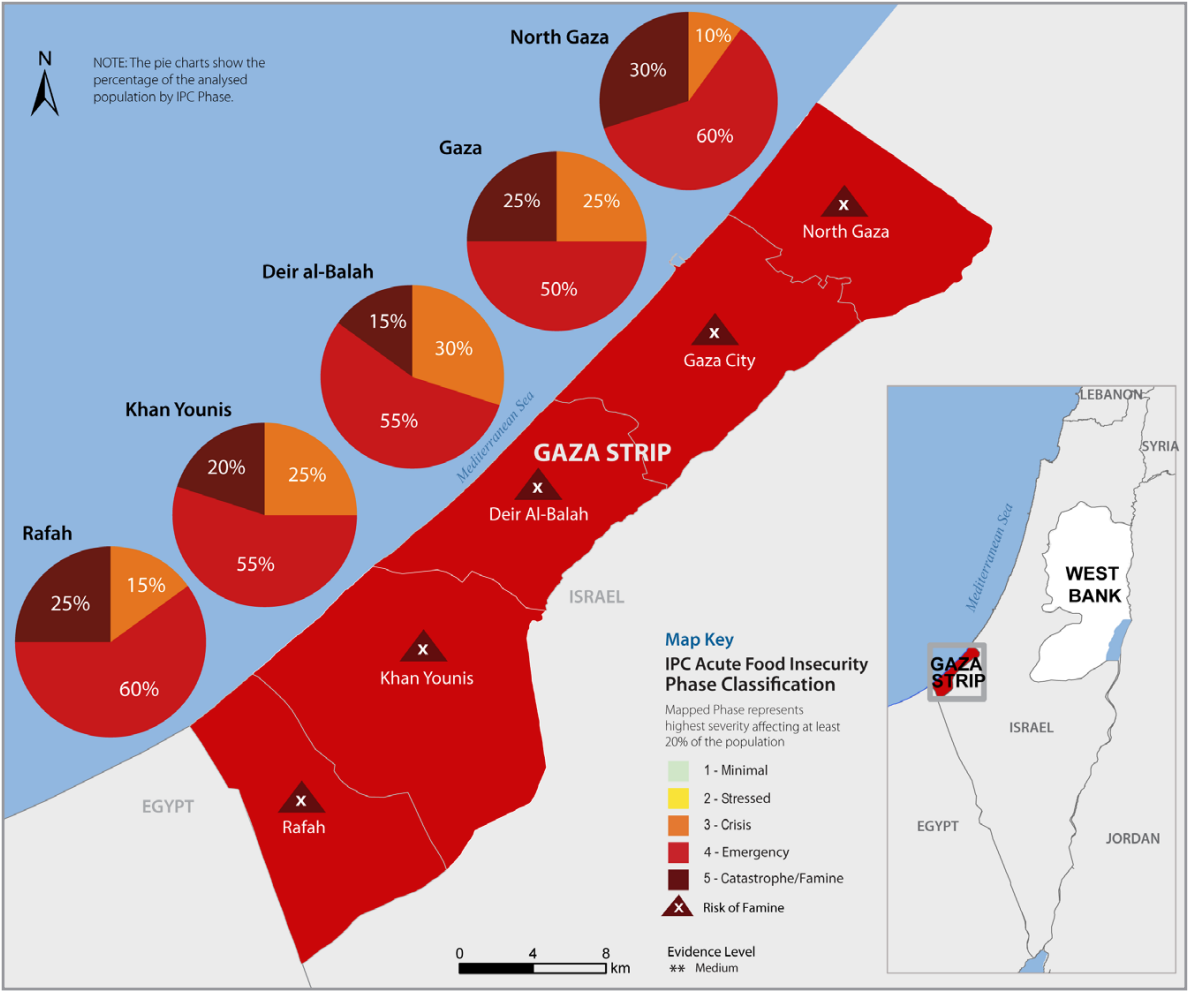Gaza’s worsening food crisis and troubled path to reconstruction

- Food Crisis and Related Risk Factors
- IPC Alerts
- State of Palestine
- Risk and Resilience
- Nutrition
- Acute Food Insecurity
Related blog posts
As the Israel-Hamas conflict rages on in the Gaza Strip, the territory’s entire population of more than 2 million remains under threat of severe food crisis. The latest alert from the IPC Integrated Phase Classification for Acute Food Insecurity reports that one in five people in the Gaza Strip—upwards of 500,000—are on the brink of starvation (IPC Phase 5 Catastrophe) due to the March 18, 2025 end of the ceasefire and the resumption of blockades of humanitarian aid and commercial supplies. The entire population is facing crisis-level acute food insecurity (IPC Phase 3 or worse).
Figure 1: Populations expected to be classified in IPC Phase 3 or above (Crisis or worse), May-September 2025
Source: IPC (April 2025). Gaza Strip: IPC Acute Food Insecurity and Acute Malnutrition Special Snapshot April - September 2025.
Unless aid and market access are allowed to resume, these dire conditions are expected to continue through the end of September. Israel’s current offensive, begun May 16, including a new invasion of troops into Gaza, has forced yet another mass displacement of the population. Under international pressure, Israel has promised to allow “basic quantities of food supplies” into the territory, and permitted an aid convoy to enter on May 22. But the United Nations and other international aid agencies have deemed this promise unlikely to stave off the risk of famine and a sharp increase of child mortality. In addition to the lack of food, the population also lacks access to medicine, drinking water, and basic health services.
The Gaza Strip experienced one of the most severe food and nutrition crises in the world in 2024, according to the 2025 Global Report on Food Crisis released last week. Though more than half of the population lived under the specter of famine for much of 2024, no actual famine was declared due to occasional resumption of shipments of humanitarian aid. This underlines the entire Gaza population’s critical dependence on stable flows of humanitarian assistance. Without effective mechanisms providing such assistance and restoration of basic services, the risk of famine will remain extremely high.
Gaza's critical dependence on humanitarian assistance also reflects the near-complete erosion of the population’s resilience and ability to cope with the crisis. Nearly all of the population has lost their livelihoods, been displaced multiple times, and seen the territory’s infrastructure, basic services, and agricultural lands largely destroyed.
Proposals have been launched to permanently relocate Gaza’s population to other Arab countries to pave the way for economic redevelopment of the territory. Such plans do not include pathways for restoration of the livelihoods and resilience of Gaza's population, and have been criticized over serious humanitarian and legal concerns, as forced displacement would violate international conventions and could cause long-term psychological, social, and economic harm. Likewise, a recent plan for the new, U.S.-backed Gaza Humanitarian Foundation to take over food aid distribution in Gaza has been strongly criticized by the United Nations others as inadequate, unworkable and lacking neutrality.
Without a ceasefire or prospects for a political solution to the conflict, reconstruction efforts for and by the population of Gaza seem extremely unlikely. However, studying feasible options for viable reconstruction of livelihoods and the territory’s infrastructure could help enhance the prospects of ending the conflict. Early recovery could be achieved through stepped-up external assistance, lifting of restrictions on workers and economic activity in Gaza, and investment in restoring basic services (health, water, sanitation, electricity, and communications connectivity), agricultural lands, and market infrastructure, as proposed in UNDP’s Non-Restricted Early Recovery (NRER) proposal.
These efforts may need to be supplemented with fast-building approaches (modular construction, prefabrication, and 3D printing) and the facilitation of a transition from in-kind to cash-based social assistance. This investment solution would require strong international support to provide initial private and public finance and to help put new governance mechanisms in place, akin to the Build-Operate-Transfer (BOT) process used in post-bankruptcy and post-conflict situations.
A rapid but humane reconstruction strategy will be essential for Gaza's stability and socio-economic recovery, which in turn could help peacebuilding in the territory. While an end to the conflict is nowhere in sight, studying the options for feasible and rapid reconstruction of livelihoods may help shed some light in the tunnel.
Rob Vos is a Senior Research Fellow in IFPRI's Markets, Trade, and Institutions Unit. Sara Gustafson is a freelance writer and communications consultant.
